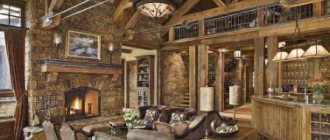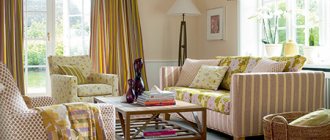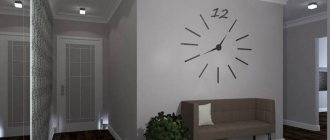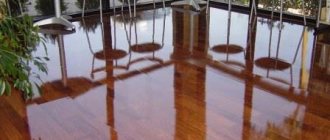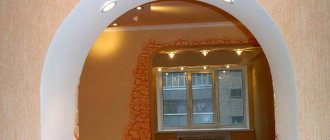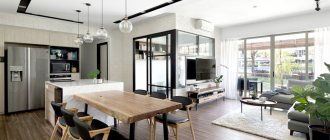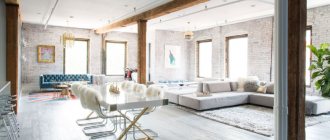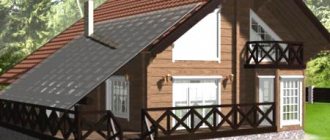From this article you will learn:
- What are the principles of designing a country house?
- What are the features of a country house in a rustic style
- What is good about the classic style when decorating the interior of a country house?
- Is there a Russian style of decorating a country house and how does it differ from others?
Many people dream of a country house. It can be large or small, used for weekend getaways or even winter quarters. Everyone has their own ideas about its purpose. To make this place truly special and make you want to return there again and again, you should carefully consider its design. From this article you will learn what styles of country house design there are and which one is best for you.
The concept of rustic style in the design of the site
The rustic style in landscape design has not lost its popularity for many decades. This is due to the following reasons:
- its installation does not require large labor and material costs;
- the style is quite democratic and leaves the owner a huge scope for creativity and self-expression;
- allows you to fully realize the site owner’s ideas about a cozy and comfortable corner for living and relaxing.
The main concept of the rustic style is simplicity and naturalness of design while preserving the natural landscape as much as possible. Well-placed accents help make the style recognizable.
This style does not dictate strict requirements for the geometry of the site and allows the use of any available materials, if they are skillfully integrated into the overall concept.
As a rule, professionals try not to give advice or set any boundaries for the owner. The main thing to warn about is moderation.
The main mistake that turns a rustic-style area into a place where random things pile up is the lack of a unified composition and an overabundance of decorative elements. Thus, it is worth remembering the principle “less is more” more often. And if the owner has ten cart wheels, this does not mean that all of them must be used when decorating a lawn or flower bed.
How to create a style from the Russian hinterland
Since the essence of rustic style is in the details, you will have to carefully create them. All work can be divided into stages:
- Site layout.
- Selection of colors.
- Arrangement of the reservoir.
- Construction of a gazebo.
- Planting flowers and plants.
Each point is given special attention. But this takes into account the area of land that is available. The truth should be stated. If the house on the site is built modern, and even decorated in minimalist or high-tech styles, then nothing will work out. Because the structure must be in harmony with the surrounding area.
Rustic country style in landscape design Source art-osobinka.ru
Site planning
Rustic style does not involve strict planning. But this does not mean that everything should be located chaotically. Zoning the site is a very important stage. The best place to start is from home.
In the article about site planning, we talked about how to correctly assess and use the relief features of a site, independently carry out a soil analysis, and determine lighting parameters. All this must be done at the planning stage of a rustic garden. Such an analysis will make it possible to correctly distribute zones across the site, making maximum use of its advantages and neutralizing its disadvantages.
The garden must have a recreation area and a vegetable garden. It is very easy to fit any outbuildings into the overall concept. Paths are not planned in advance. They simply randomly connect selected zones.
Country house in country style and its decoration
An ordinary wooden house made from a log frame would ideally fit into the overall picture, but a stone structure within the framework of the described style will look quite organic (as long as its appearance does not in any way resemble modern mansions, but echoes those structures that are being built in the countryside).
Another interesting and quite suitable option is a house whose external walls are covered with rough white plaster.
Note: if you plan to install or build a greenhouse structure on the territory of your personal plot, keep in mind that glazed gable greenhouses made of wood fit well into the picture of a rustic style, while structures covered with film or polycarbonate will look less advantageous.
Fences and enclosures
A country-style dacha and a country garden require the most uncomplicated fences and fences - pickets and wattles, made by yourself. It is important to note here that before the construction of these structures, all wooden elements should be treated with anti-rot mastic and special antibacterial drugs, which will greatly increase the service life of the finished structures.
A more durable, but also more expensive option for fencing a site is a stone fence with deliberately rough, uneven surfaces. It will look especially good against the backdrop of a country house, lined with stone of the same type. To soften the texture and coldness of the stone, well-known (but not exotic!) climbing plants are usually used - hops, wild grapes, climbing roses.
If the backyard area is already fenced with a metal fence, then the use of climbing plants is an excellent way to decorate the metal, which is not particularly welcome in the country concept.
Unity of style
Rustic style is often called "country". However, the rustic style should not be confused with the ethnic one, which implies strict adherence to the national flavor.
To create a recognizable look and style, it is quite acceptable to stick to a certain theme, which will greatly simplify the task. This could be an imitation of a Ukrainian farmstead, a house in the Russian outback, or a farm in France. After all, for example, when mentioning a Ukrainian farm, the imagination immediately pictures pots on the fence, an abundance of sunflowers, a whitewashed hut, a table under a pear tree in the yard.
In a word, to create a landscape design in a rustic style, it is enough to think through the style and acquire suitable materials at hand, as well as drawings and old photographs.
It is worth remembering that the house, if it has already been built, must be brought into line with the chosen style. Modern building materials will allow you to do this quickly and efficiently. It is also worth thinking, for example, about the installation of shutters and carved platbands.
Country house in Provence style
The Provencal direction not only embodies the atmosphere of rural life of the southern province and its culture. It creates a feeling of calm and relaxation. Inside a country cottage decorated in this style, the rays of the hot sun are always shining, the sound of the sea surf is heard, and the air is saturated with romance.
Rustic-style design for a country house is created from simple details, artificially aged materials and antique decorative elements. Its characteristic features are:
- no heavy curtains;
- lack of bright and saturated colors;
- large windows with many sections;
- the color of the ceiling and walls is several shades lighter than the floor;
- the main pattern is floral;
- aged furniture elements;
- textiles are made only from natural fabrics.
In such an environment there are no bright, flashy colors. It is dominated by soft and calm pastel shades. And the basis for decorating rooms, furniture and decorative elements is most often white or another light color. The fact is that the weather in the homeland of Provence is very hot, so local residents tried to create a feeling of lightness and coolness in their homes.
Recommended articles on this topic:
- Renovating a living room in a country house
- Installation of automatic gates
- Septic tank for a private house
The walls in rooms are usually decorated with decorative plaster, which is applied in various ways. Therefore, they may be rough and uneven. Light shades for vertical surfaces are selected. Thanks to this, the space is visually enlarged and refreshed. It gives a feeling of cleanliness and the ability to use any decor. Often, plaster is specially applied to walls with uneven surfaces.
Wooden panels are also suitable for wall decoration in this style of country house design, if they are made of natural wood. Provence allows you to paint them beige or white, complement them with artificial abrasions.
The ceilings are also decorated with light shades or whitewashed. Sometimes the surface is decorated with wooden beams, emphasizing contrasts, and artificial aging is used. The ceiling in the dining room or living room can even be decorated with stucco. In any case, it should be light, with contrasting wooden beams.
This style of farmhouse design traditionally uses wood floors. However, they can be painted or left untreated. It is important that the finishing materials are natural and of high quality. When decorating a kitchen or other utility rooms, you can lay, for example, brown tiles on the floor.
It is also used for the kitchen or bathroom, because it is very practical in terms of cleaning.
Furniture in Provence should be massive, forged or wicker. It is prohibited to use products and accessories made of steel and plastic. If your budget does not allow you to purchase natural wood, it can be replaced with chipboard or MDF with high-quality imitation. In general, rural design implies the presence in the interior of furniture made of solid wood or worthy imitation with a characteristic design.
Creative owners of country cottages can even find suitable items at market sales, from acquaintances or friends, and then organize and restore them themselves. Mezzanines, chairs, cabinets, chests of drawers, and sideboards are used as the main decorative elements in Provence. They must certainly be large in size, in good condition, painted in light, pastel shades. Various paintings and engravings on the facades are also allowed.
Fabrics should also be natural - chintz, silk, linen or cotton.
The desired mood in the room is created with the help of an abundance of various decorative elements, many of which can be made with your own hands. Paintings depicting nature and rural life will harmoniously decorate the walls of the rooms. And on tables and shelves you can put small wicker baskets, candlesticks, or put lace napkins and ceramic dishes. Mirrors should be framed with forged frames. In addition, the village cannot do without flowers in pots and cache-pots.
Fencing
A fence in a village house has always performed many functions: it reliably protected the family from prying eyes, and served as a place where something could be hung to dry. The condition of the fence spoke about the owner’s wealth. Therefore, the fence should be taken seriously.
The fence should be wooden, but its shape can be different:
- wattle fence;
- fence;
- stylized fence from any available materials.
If a gate device is planned, they also need to be integrated into the overall picture, giving the appropriate appearance.
Well
One of the most important techniques in the design of a rustic style is the installation of a well. This is the most labor-intensive and expensive detail of the overall style. Of course, you can stylize a well as a decorative element, but it is best to arrange a real well, which, among other things, will become a source of water for domestic needs and irrigation.
To design the frame of a well, it is worth familiarizing yourself with what wells looked like in villages. Their appearance depended on the design of the lifting mechanism. In Slavic villages, two types of wells were most often used:
- Russian (with a lifting mechanism in the form of a drum on which a rope or chain is wound);
- crane with a lifting lever mechanism.
The upper part of the shaft (head) must be decorated in the style of the general design. The area around the well can be cemented, or it can be planted with flowering shrubs or ivy.
Garden furniture and small forms
The main rule for the location and type of garden furniture is minimum cost and ease of use.
Benches that have served their time, wooden tables, just wooden blocks and old stools - everything can come in handy. Handmade furniture is ideal.
Professionals do not advise getting carried away with garden sculptures when decorating in a rustic style. It is better to give preference to rustic household items - old (or stylized) carts, kitchen utensils, antique bicycles, garden wheelbarrows, garden stuffed animals, wicker baskets.
Pet figurines and sculptures are perfect for the overall concept. Boulders or old stumps covered with flowers will look good.
Landscaping of the site
Lawns, if they are sown, should not have geometric shapes and look well-groomed. Flowerbeds can be arranged completely arbitrarily. A certain negligence and lack of care is quite acceptable - village housewives most often did not have time for ideal flower beds.
Very important elements of this style in landscape design are the garden and vegetable garden. A garden planted with fruit trees will not only create an atmosphere that suits the style, but will also produce a harvest.
In addition to traditional “food” vegetable crops, you can grow colorful giant pumpkins, sunflowers, and ornamental cabbage used in design.
Using all these simple techniques, you can turn your garden plot into a corner of comfort and harmony with nature, without any special financial costs. Caring for a site in this style is not at all difficult, and an already created landscape design can be easily updated and redone with your own hands using available tools.
Many people think about creating a rustic coziness in their dacha or the area in front of their house. But only a few can figure out how to do this correctly without huge investments and with their own hands.
Don't worry, everything is natural and simple in country style. The main thing is to know a few important secrets.
Site development rules
At first, it may seem that the rustic style is a “lyrical mess”, so there is no need to put effort into creating it. This opinion is wrong; behind the apparent negligence there is labor and time spent, but these worries are pleasant and bring excellent results.
When arranging a site, several points are taken into account: the layout of the territory, the design of the garden and vegetable garden, and decorative elements.
Territory planning
Even a small summer cottage can be beautifully decorated in country style. First of all, they pay attention to the house: it must correspond to a rustic design, its walls must be wooden or plastered. Under no circumstances should you cover your house with modern materials such as siding.
When planning the territory, the following rules are followed: there is no clear zoning, but there is a conditional division into zones, each of which has its own purpose. The site should have:
- Entrance area. The main path is located on it . It is best if it is made of flat stones, with small grass growing between them. The path leads to the house; along its entire length and near the entrance to the house there are flower beds. Climbing plants will look good on the walls of the house. On the sides of the path, lawns look nice, sown with lawn grass interspersed with meadow flowers (clover, daisies, sweet peas).
- Economic zone. Here are located auxiliary outbuildings (shed, garage), perhaps a compost pit, and other necessary structures. All auxiliary buildings should be hidden behind green spaces: these can be lush shrubs or climbing plants.
- Gardening area. There is a country garden here, where fruit bushes and vegetables are planted. In small areas, the gardening area is combined with the economic area.
- Rest zone. It is being installed near the house. This could be a veranda or a canopy attached to the house. Benches, swings and a hammock are placed nearby. A separate recreation area is arranged in remote corners of the garden, where a gazebo covered with climbing plants is installed.
Garden design
A country garden must combine decorativeness and practicality: it must be beautiful, and the trees must bear a good harvest. Such a garden will look especially attractive in the fall, when fruits flaunt among the leaves.
Shrubs (raspberries, gooseberries, red and black currants) are placed separately. When planting them, you must not forget about accessibility to a water source, since shrubs need more frequent watering than fruit trees.
Beds with vegetables look good if they are given an original shape; the rustic style is emphasized by beds framed with boards. Among the vegetables, calendula or marigolds are planted - these plants not only add decorative value, but also help fight vegetable pests.
Thickets of parsley and dill are combined with low flowers, and decorative varieties of onions can be sown nearby. Pharmacy beds are extremely popular among gardeners - they grow medicinal plants - mint, sage, chamomile, thyme.
Decor elements
The decor of a site decorated in a rustic style should be simple and natural. All items must be made from natural materials (clay, wood, wicker, stone); the use of iron is allowed. You cannot use plastic elements, as such design will remind you of the city and its rhythm of life.
Wooden garden furniture can be purchased at the store, or you can make it yourself. It is very easy to build a table, benches and stools from boards; if desired, you can build a gazebo. It is much more pleasant to use items made by yourself. They carry unique energy and take people back to the past, when there was no scientific and technological progress and most of the necessary items were made independently.
Decorative little things add unique charm: a cart wheel, a broken jug, a garden scarecrow, a watering can for flowers. These items are placed on the site, combining them with mini-beds and flower beds. Wicker baskets made of wicker can be used as flower pots; wooden figurines of animals and fairy-tale characters will organically fit into the design.
A mandatory element of country-style decor is a wicker country fence. It is usually used as a design element near the house, as well as to separate different areas of the site from each other. The color of the fence is given by clay jugs and mallows and sunflowers planted nearby.
If space allows, it would be a good idea to equip a small pond on the site; you can put turtles, fish and frogs in it. A pond creates an atmosphere of peace; water promotes relaxation and calms the nerves.
Country style landscape: a little history
The country style in the design of summer cottages came to us from Western Europe, and specifically from the famous design expert Gertrude Jekyll from the British Isles. At that time, English gardeners grew fruits, vegetables, fragrant herbs and flower arrangements in their cottage gardens to decorate their homes. Gertrude revealed all this untouched beauty to the world, complementing it with refined aestheticism and utilitarianism.
Europe accepted this innovation with open arms, and after several years a colossal number of plots in rural country style appeared on its territory. Ornamental vegetable gardens and bright, fluffy flowers did not require painstaking care, which largely influenced their growing popularity. Each nation has contributed to this style, and the country that we know today is the merit of the British, the French, the German burghers, and the American cowboys.
The beauty of a village flower garden
If you decorate the flower garden with a small fragment of a fence woven from willow twigs or other long and thin branches, and hang a number of different pots and jars on top of its stakes, then it will completely correspond to the country style.
The flower garden must be extremely variegated. Decorative flowers are usually located next to wildflowers. Sunflowers, daisies, cornflowers, and pansies can be a good solution. It is necessary to alternate plants correctly to obtain a unique and beautiful composition. This landing will not take much time and will not require much effort. The annual flowers that form its basis are sown immediately in previously prepared soil.
Located, as a rule, right next to the house, the flower garden should be very decorative. But spicy herbs, which get along well with other plants, will also be relevant. This is a delicate oregano with thin branches, a spectacular lemon balm, with dark green leaves, or lovage, with tall yellowish umbrellas. But the range of useful plants can be expanded. The main thing is to correctly distribute the zones for growing them and not spoil the overall composition.
Distinctive features of the country style plot:
- A riot of colors in the form of tomato bushes, golden-headed sunflowers, orange pumpkins, flowering fruit trees, beds of strawberries and all kinds of garden greens is an indispensable feature of the site, the design of which is planned in country style.
- Fences woven from vines, supports for climbing flowers, wooden decks and winding droshky, swings and for watering plants will successfully fit into a style based on environmental purity and naturalness. Wood is the main material for making small forms in the garden.
- Old things, parts and paraphernalia that we inherited from relatives: cart wheels, low fences made of stakes and poles, wooden benches, buckets and watering cans.
- It is not recommended to plant flowers, shrubs and trees strictly according to varieties, types and areas. Everything should create the impression of some negligence and nature untouched by human hands. A country landscape may resemble a fragment of a summer meadow, garden or forest clearing, in which it is impossible to violate any laws of geometry or clear lines, for the simple reason that they simply do not exist.
- An open gazebo made of a log frame, fenced with a low palisade, and a garden bridge spanned over a small stream look organic on such a landscaped area.
Creating a romantic corner in a natural and simple (but at the same time carefully thought out) landscape is the main task of country music.
This democratic style perfectly reflects the Russian mentality, without requiring significant labor and monetary costs.
Read on to find out which plants and decorative elements are preferable to choose for a country-style plot, and which shrubs and flowers are best to avoid.
Useful tips
Landscaping in a rustic style gives complete freedom of action; even a person without experience and artistic skills will be able to beautifully decorate their site. Here are some tips that will be useful for beginners when decorating a site in country style:
- Do not divide flowers and non-flowering plants by variety. They should be mixed together to create the impression of naturalness.
- Use climbing plants wherever there are conditions for their growth. The more greenery, the more beautiful the area.
- Country style lawn grass is usually not trimmed. The exception is the design of the site in the style of a manorial estate.
- All paths on the site should be winding, not too wide. At the same time, they should be neat and comfortable for walking.
- Do not plant exotic plants in flower beds. All flowers should be simple, some of them should be perennials - this makes it easier to care for the flower garden. Select plants so that they bloom from early spring to late autumn.
- To get inspired by ideas, look at pictures and videos on the Internet before arranging your site. But don’t copy the design from your friends and acquaintances - let your site be original.
- Don’t be afraid to experiment when designing your site, but remember the main rule: no artificial materials, everything is only natural!
Step-by-step design of a summer cottage in country style:
- A rural-style plot of land should be correctly divided into several zones, delimited (fenced off) from each other by a hedge of wild grapes and hops, or a wicker fence.
- The driveway to the house is surrounded by flowering fruit trees, birch or rowan trees.
- The path to the house should not be straight and neatly paved. The rustic style suggests seemingly untrodden paths along which the human foot steps only occasionally. To create such paths, materials such as natural stone, gravel or granite screenings are suitable. These elements are laid at small intervals, between which lawn grass or ground cover plants (for example, thyme or St. John's wort) are sown.
- In front of the house, a blooming lawn with several types of flowers will look harmonious: calendulas, poppies, cornflowers, daisies, daisies, carnations, etc. A perfectly evenly trimmed lawn contradicts the very essence of the rustic country style.
- Low buildings in the economic zone are decorated with wild rose thickets, lilacs or viburnum.
- It is impossible to imagine a rustic style in landscape design without a decorative vegetable garden with original-shaped beds where cabbage, lush greens, lettuce and onions grow. You can separate the vegetable garden from other zones with the help of gooseberry bushes, red and black currants.
- And, of course, a garden with fruit trees and flower beds with undemanding perennials will add special charm to the site: delightful phlox, delicate bells, proud poppies, important peonies, heat-loving dahlias and colorful pansies. But topiary trimming of plants or neat slides of stones in the country are not welcome.
- You can complement a country-style garden with the most popular rustic elements: a homemade straw effigy, figurines of birds and animals, an old wheelbarrow with fresh flowers, or garden sculptures made from sections of a tree trunk.
Features of rustic style
If you spent your childhood holidays in the village, you will never forget it. You can return to the site created according to the prototype, as if you were a child, after a hard day’s work and plunge into the world of a serene idyll with bright colors of impressions.
The direction came to us from England, where it was invented at the end of the nineteenth century. British artist Gertrude Jekyll realized her opinion of how a piece of rural life should ideally look through the eyes of a city dweller. But it’s true that Americans, as always, attribute the discovery of the style to themselves. After all, the word “country” came from them.
Classic village landscape with a real hut Source omelchuck.ru
And although at first glance everything looks chaotic and careless, there is deep thoughtfulness in every detail of the landscape. Any design element is fully compatible with its surroundings. And the simplicity of the overall idea just breathes comfort and warmth.
To convey all the nuances of rural life, the site will need:
- The house is small in size and preferably wooden. Stone walls can be sheathed, plastered and whitewashed. Or add an open wooden veranda to the façade.
- Lawn in the foreground.
- Garden with fruit trees.
- Several wild trees scattered around the area. Birch, rowan or bird cherry are well suited for the style.
- Furniture from a garden set placed around the site.
- Plant the entire area with flowers. Moreover, meadow species should dominate.
- Place outbuildings behind fruit and ornamental bushes.
- Be sure to build a cozy gazebo for relaxation in the village garden. And hide it from view.
- Place a small pond next to the recreation area.
- Bring a small vegetable garden with neat beds to the foreground in the garden.
- Enclose all planted cultivated plants with a wicker fence.
- Scatter special decor throughout the area. Rustic utensils from the last century are best suited. Wicker baskets, clay jugs and simple lamps. The ancient cart looks great on public display.
For style, it is advisable to use only natural materials. As a last resort, artificial ones will do, but they imitate natural ones well. More wood, as well as stone and less metal. Homemade simplicity and a little carelessness should be visible in all things.
Ostentatious negligence in everything hides thoughtful details Source yandex.kz
Elements that are externally perfect will look alien in this rural landscape. You can use sculptures. But they should reflect a rustic style. Various stuffed animals and figurines of forest animals are well suited. New-fashioned gnomes and ancient statues with geysers are not appropriate in the village.
The main distinguishing feature of a country-style site is that it should be dominated by plants that do not require constant care. Although a lot of work is hidden behind such a rural idyll, you need to create the impression of untouched nature.
Country style in landscape design - photo
Each owner of a dacha or suburban area designs the area adjacent to the house in accordance with his own ideas about a comfortable life. Some people like the English neatness of lawns, others are delighted with alpine slides, and others like simple village life with all the accompanying attributes. Today we invite you to see why the rustic style in landscape design is so good, what are its main features and what needs to be done to envelop your site in comfort?
The main characteristics of the rustic style in the design of the site
- Perhaps the first and main feature of the rustic style in the landscape is its simplicity. Everything here looks nice and pleases the eye, but the lawn grass is not measured down to the millimeter, but grows as it pleases, the same flower pots do not stand, but on the contrary, flowerpots of different sizes and design styles are adjacent to each other, beds with vegetables and flower beds with flowers, but organically combined on one territory. But, despite all the apparent chaos at first glance, you will not find chaos on the site. Everything here has been tidied up by the caring hands of the owners, and rounded and natural shapes are preferred to clear and concise shapes in the design of the site.
- So we have brought out the second component of the village landscape - its naturalness and authenticity. It’s as if everything here was created not by human hands, but by nature. You won’t see any rare or exotic flowers here, but even if an unusual variety of rose suddenly grows in the flowerbed, it will probably be adjacent to “simple” pansies, cornflowers and petunias.
- And just like that, the third distinctive feature of this style emerged imperceptibly - negligence. Just don’t confuse it with sloppiness; you won’t find that on a rustic-style plot.
Carelessly arranged decorative elements create the impression that they were just forgotten on the street by the owners entering the house, and the disorder of neighboring flowers in the flowerbed resembles a forest clearing, a flowering field or a meadow, where no one would even think of planting flowers by variety: cornflowers to the left, and yarrows to the right . As nature “planted” them, so they grow.
Rustic style in the landscape
Decorating a garden in a rustic style
How to arrange a plot in a rustic style
The most suitable materials for these purposes are wood and stone. What is most associated with country life? That's right, a log house, surrounded by greenery, a wicker fence and bright flowers breaking through it. By the way, nowadays it is not necessary to build a wooden house in order for the resemblance to the prevailing stereotypes about the rustic style to be accurate. Modern materials will help solve the problem; for example, wood-look siding is perfect for these purposes. By covering your house with wooden siding, you are already one step closer to realizing your dream.
A rustic fence is either a wattle fence or a wooden picket fence. In any case, we again return to natural material - wood.
Beautiful fence in a rustic style photo
Rustic style plot design
A gazebo and pergola will also be made from it, benches and a table will be made. By the way, if we talk about a rustic-style gazebo, the most interesting option would be one built from untreated boards with a thatched roof. More modern options combine wooden construction, roof tiles and decorative wrought iron elements.
Pergola with swing in the garden photo
Garden paths are also not deprived of attention; they are lined with rough paving stones, stones, sawn wood, or simply covered with gravel or sand.
How to design a vegetable garden in a rustic style
Not a single village plot is complete without a vegetable garden and orchard. Vegetables and herbs grow in the garden, and the garden is surrounded by greenery and generously rewards the owners with a harvest of fruits and berries. Even if your plans do not include stocking up on vegetables and fruits for the winter, growing a few bushes of carrots, cabbage, tomatoes, cucumbers, eggplants and zucchini will not burden you, believe me! But how nice it is to make a salad from freshly picked tomatoes and cucumbers, add herbs and herbs from the garden and season with fragrant sunflower oil. So much for the delights of country life!
In a rustic garden, mixed growing of vegetables, flowers and herbs is practiced. Here, between the rows of tomatoes and carrots, you can see the bright “lights” of marigolds and zinnias. And shallots, parsley and dill neatly frame the beds of peppers.
Rustic style vegetable garden photo
In the garden, designed in a rural style, only fruit trees grow, and they are not planted strictly in any order, but somewhat chaotically, combining different species and varieties in one area. At the same time, the owners do not set records for harvesting; for them, working in the garden is, first of all, a pleasure.
Rustic style flower beds are sure to be a riot of colors. Both wildflowers and garden flowers coexist perfectly in the same area; the main thing is to give preference to simple species: tulips, daisies, decorative sunflowers, marigolds, zinnias, cornflowers. The alternation of contrasting buds on one flower bed, where blue intertwines with yellow, and green shades red, looks especially advantageous.
The primacy of accessories
What there cannot be in abundance on the site is decorations. For example, small architectural forms in the form of a cart wheel, wooden sculptures, stuffed birds and animals will help to organically complete the created rustic style. A fairly popular element of decorating a country-style estate is a decorative cart or garden wheelbarrow, which, along with other peasant household items, is most often used as a flower bed. Agree, growing flowers in a cart, watering can, teapot, old bucket, chair, wooden tub or worn-out shoe is much more interesting than in the ground. In addition, this is a rather bright decor of the site.
Land development always begins with a plan. Rational use and artistic design of a personal plot are possible only as a result of its correct and thoughtful planning, taking into account natural, climatic, local, national and everyday features. In this article we will tell you how to decorate a garden plot with your own hands in a village using scrap materials, and we will give video and photo instructions on how to decorate it.
The smaller the area of the site, the more carefully you need to plan it and think through the design details.
We design flower beds at the dacha in a rustic style ↑
Let’s get started with the most enjoyable work at the dacha – decorating the flower beds. If you work with these elements with your soul, you can create bright and at the same time organic flower beds, pleasing to the eye and relatively unpretentious in care. Usually there are several flower beds in the garden, and one of them is assigned the role of the central element. The peculiarity of each of the flower beds is that vegetables and flowers are planted on them in close proximity. For example, cultivated plants such as corn and ornamental cabbage, salads and sunflowers are used in decoration. Asters and hollyhocks, nasturtiums and dahlias, marigolds and pansies, calendula and daisies go well with them.
In a rustic-style flowerbed, flowers show all their beauty without hesitation.
It is necessary to take care not only of the flower beds, but also of all the vegetation on your territory. However, this concern is relatively specific. Unlike other styles in the landscape, rustic suggests that not a single lawn or lawn in the country should look well-groomed. On the contrary, herbs and wild plants should grow on them, beautiful due to their spontaneity and naturalness.
Relief
When placing elements of the estate and choosing plantings, it is necessary to take into account the location of the place relative to the sides of the horizon, prevailing winds, the condition of the soil and ground, as well as its topography. Natural relief does not always and fully satisfy planning requirements; in such cases, it is recommended to carry out vertical planning.
For small elevation differences (up to 5%), no excavation work is carried out, leaving the natural topography, and the house is built with a basement or ground floor, or only the site for building the house is leveled.
In areas with a steep slope (8-12%), the situation can be corrected by terracing the area across the slope, and the steeper the slope, the more terraces are needed. Stairs are installed between the terraces, and the surfaces of the terraces are connected by retaining walls. As a rule, for small slopes with clayey and sandy loam soils the slope is 1:1.5, for sandy soils - 1:2, that is, a slope 1 m high occupies a strip of land 1.5 or 2 m.
Fence
In addition to their direct functional purpose, fences also play a decorative role, so the arrangement of a personal plot can begin with the installation of barriers. It is better to make the outer fence human height or slightly taller, and the inner fences can be installed with a height of 30 cm to 1 m. The fence consists of posts and sheathing; the materials for the fence can be different.
In addition, the fences can be made in the form of a hedge, planting it in two rows, between which a low metal mesh is stretched. After 2 years, the bushes will grow into it and make it invisible.
Various types of hawthorns, thuja, Japanese quince and others are well suited for green fencing. The bush is trimmed in the second year. Hedges are formed by side and top trimming, which is carried out 2 times a year.
We invite you to watch a video about an alternative option for constructing a hedge.
When designing a personal plot, special attention should be paid to paths. Their correct and beautiful layout plays an important role in landscaping and decoration. The general design of the paths can be geometrically strict or free. There is a direct connection between the paths, the relief and the shape of the site.
First, marking is carried out - straight sections of the paths are marked using a cord, the ends tied to pegs, and curved sections - using one peg as the center of the circle, and the other as the leg of the compass. It is easy to draw smooth curves on the ground by changing the length of the cord and the location of the center.
If you want to lay paths with artificial turf, you need to carry out preparatory work. Along the marking lines, the turf is cut to a depth of 15-20 cm and removed so that a small elevation remains along the central axis so that rainwater flows to the edges. This place prepared for covering is called a “trough”.
Paths can be made:
Ground
— along the stretched cord, use a shovel to cut the edges of the path to a depth of 10 cm. This layer of earth is removed, and the cut area is rolled with a hand roller.
For such paths you only need to sow lawn or white clover. This is exactly how many people design the driveway to the garage, paved with paving slabs for the wheels.
Gravel
- a layer of 7 cm of coarse gravel (4-6 cm) is placed at the bottom of the “trough”, after rolling it - another layer of 5 cm of finer gravel (2-3 cm), and then a layer of sand mixed with clay (1:3 ) 1-2 cm thick, which is compacted well, while watering it with water for better shrinkage. Lastly, another layer of 2 cm of fine gravel is laid, which is also watered and compacted.
Perhaps the most aesthetic type of paths, because such tiles can be of any shape and color and fit perfectly into the design. A dry mixture of sifted sand and cement (4:1) is poured onto the “trough”, and then concrete tiles are laid one at a time, which are leveled and compacted using a rubber hammer. Laying paving slabs is not difficult.
Wooden end paving
- effective and very economical, since wooden “rounds” can be cut yourself. To make such paths, tree trunks of various sizes are treated with an antiseptic (bitumen, drying oil), and then sawed into equal sections of 10-15 cm. Such logs are placed on a 10 cm layer of sand. Small ones are placed in the space between the large ends, and the remaining voids are filled sand.
Made from monolithic concrete
- for such paths, formwork is prepared, which is filled with plastic concrete with fine gravel, prepared at the rate of: 1 part cement, 2 parts sand and 3 parts gravel.
And a few more photos of various paths for a summer cottage:
We invite you to watch this video dedicated to the arrangement of paths.
Front garden and green lawn
When doing work such as landscaping a personal plot,
you can quite simply make it beautiful, clean and elegant by sowing the free space with lawn grass. Such lawns provide places for relaxation, picnics and sports games.
You can also sow lawn grass in the front garden in front of the house, where small trees or shrubs planted in groups look good. In this case, the tallest trees or shrubs are planted in the center of the group, and the shorter ones at the edges.
When planting flowering shrubs in the front garden, their color scheme is taken into account - plants with white, yellow, orange flowers are planted closer to the house, and at a greater distance, near the paths - with red, purple, blue and dark or red-leaved bushes.
The physiological and psychological effects of flowers and their smells on the human body have long been known. Decoration of a personal plot - color compositions are compiled according to the following design rules:
- compliance with color ratio
. Red - green, purple - yellow, blue - orange - such combinations create contrasting and emotionally effective relationships. The color combinations are soft and harmonious: red - yellow, red - blue, purple - orange, purple - green, blue - yellow. White color goes with all colors. When creating flower beds, you need to remember that flowers of warm, soft and harmonizing tones are placed in well-lit, sunny places, and contrasting colors are placed in shaded places. - continuous flowering if possible.
To do this, you need to select flowers with different flowering times. So, in April snowdrops, crocuses, daffodils, and tulips bloom; in May - forget-me-not, lily of the valley, violet, iris, lily, peony; throughout the summer - gladiolus, phlox, purple dicentra, poppy, bell, delphinium; in September - aster, goldenrod, dahlias; in October - chrysanthemums. Roses have a long flowering period - from May to September.
Flowerbeds are arranged in the front garden, on recreation areas, rocky hills, slopes, terraces, and near a pond. The background for the flowers is a green lawn, stones, house walls, and tree trunks. When planting flowers in a flowerbed, you need to take into account that flowers of the same type, but of different colors, look very beautiful together. Variegated mixtures of tones are undesirable. A flowerbed does not become beautiful because there are many types of flowers on it. It is not the quantity that is important, but the harmony between colors. Another rule for arranging a flower garden is that the further the flowers are planted from the path, the larger the color spot can be and the higher the flowers themselves.
When choosing flowers, it is necessary to take into account their requirements for soil and light, the growing season, resistance to wind, time and period of flowering, decorativeness, plant height, etc.
Roses occupy a special place in the landscaping of the site. Almost continuous flowering and a wide variety of colors put the rose in first place in the decorative design of the site. Roses are planted in a sunny, bright place, protected from the wind. Climbing roses are planted on the south side of the house. An excellent background for these flowers is a green lawn, coniferous trees, stones of retaining walls and terraces.
